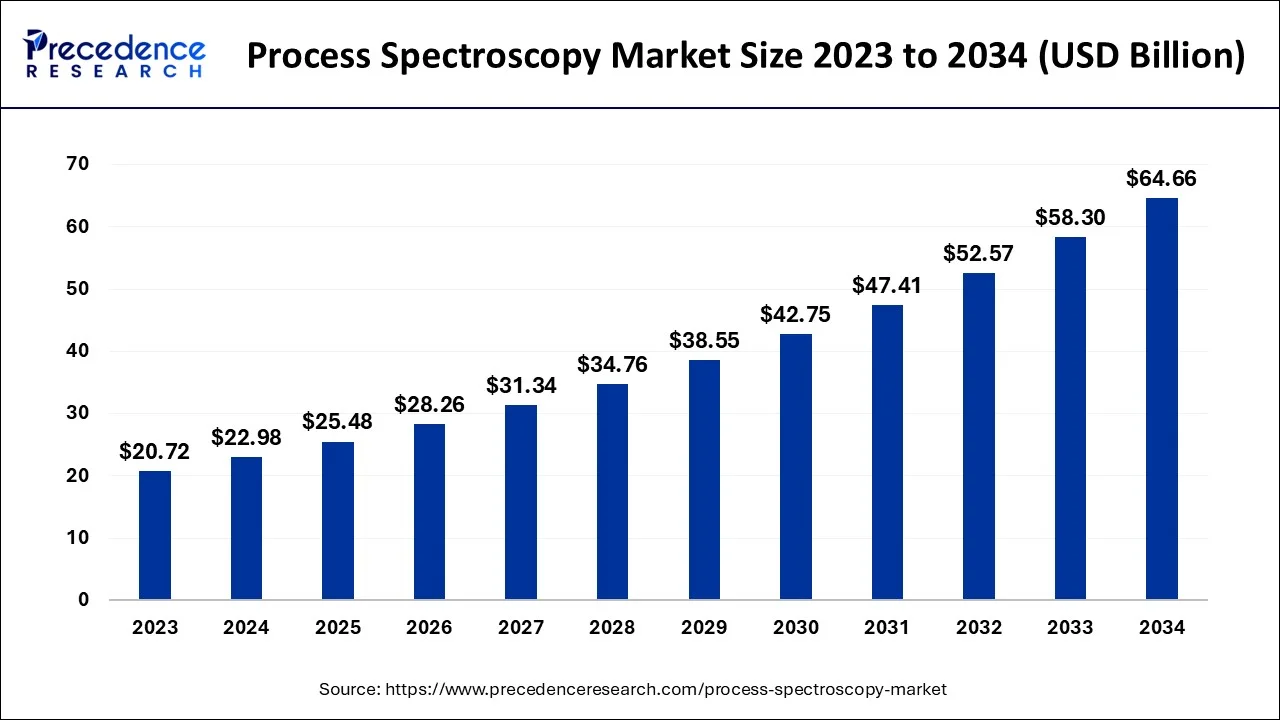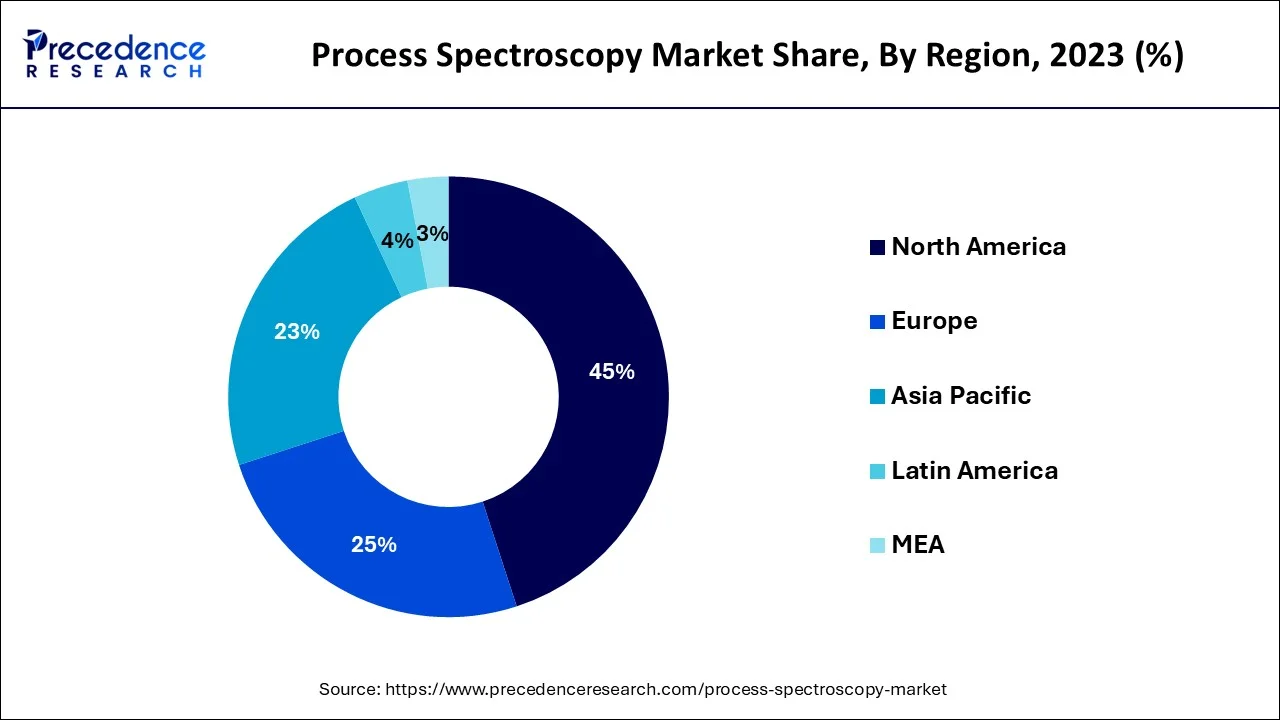September 2024
The global process spectroscopy market size accounted for USD 22.98 billion in 2024, grew to USD 25.48 billion in 2025 and is projected to surpass around USD 64.66 billion by 2034, representing a healthy CAGR of 10.90% between 2024 and 2034. The North America process spectroscopy market size is calculated at USD 10.34 billion in 2024 and is expected to grow at a fastest CAGR of 11.01% during the forecast year.
The global process spectroscopy market size is estimated at USD 22.98 billion in 2024 and is anticipated to reach around USD 64.66 billion by 2034, expanding at a CAGR of 10.90% between 2024 and 2034.

The U.S. process spectroscopy market size accounted for USD 7.24 billion in 2024 and is estimated to reach around USD 7.24 billion by 2034 growing at a CAGR of 11.08% from 2024 to 2034

On the basis of geography, North America accounted for the largest revenue share of the process spectroscopy market in 20232 and is expected to dominate the market during the forecast period. The market is witnessing significant growth in North America owing to the rising production of shale gas in the U.S. and Canada. The region has the potential for investments in a variety of technical advancements and is well-equipped with the infrastructure for varied R&D across all the major industrial sectors, including food and beverage, pharmaceutical, and chemicals.

Asia Pacific is expected to have the fastest growth during the forecast period owing to its developed R&D processes and strong manufacturing hub. The use of spectroscopic technologies for the extraction, processing, and distribution of oil and gas in these nations has led to a rise in the use of spectroscopy tools and techniques, which is fuelling the market size at a significant rate. All these variables have greatly boosted the use of spectroscopic techniques, aiding in regional development.
The process spectroscopy market refers to the use of spectroscopic techniques to monitor and control chemical and physical processes in various industries such as pharmaceuticals, food and beverage, oil and gas, and chemicals. Process spectroscopy involves the use of instruments such as spectrometers, sensors, and software to analyze the composition and characteristics of materials in real-time during production processes. This information is used to optimize process conditions, improve product quality, and reduce waste and energy consumption. The market for process spectroscopy is driven by the increasing demand for quality control and process optimization in various industries.
The pharmaceutical industry, in particular, has seen significant growth in the adoption of process spectroscopy due to regulatory requirements for process monitoring and control. Other factors driving the market include the increasing use of spectroscopy in food and beverage processing, the development of advanced spectrometer technologies, and the increasing focus on sustainable production practices. It has become one of the best techniques for analyzing finalized products owing to its various beneficial features. Processes that use spectroscopy can save time and money by lowering the overall cost of monitoring operations, among other things. Increasingly, process spectroscopy is being used in the medication safety process, in the demand for reliable water and wastewater treatment, and in the expansion of oil and gas process operations. Growing consumer awareness of the value of high product quality has a positive impact on the growth of the worldwide process spectroscopy market. Consequently, one of the main factors contributing to the increased use of process spectroscopy in the global market is the rising demand for products of higher quality.
| Report Coverage | Details |
| Market Size in 2024 | USD 22.98 Billion |
| Market Size by 2034 | USD 64.66 Billion |
| Growth Rate from 2024 to 2034 | CAGR of 10.9% |
| Largest Market | North America |
| Fastest Growing Market | Asia Pacific |
| Base Year | 2023 |
| Forecast Period | 2024 to 2034 |
| Segments Covered | By Technology, By Component, and By Application |
| Regions Covered | North America, Europe, Asia-Pacific, Latin America, and Middle East & Africa |
Rising focus on achieving international quality standards
To satisfy international standards of quality like ISO or Six Sigma certification, several industries around the world, including pharmaceuticals, food and beverage, agriculture, pharmaceutical, and chemical are attempting to improve the quality of their product. Nowadays, there are over 162 standard groups that represent ISO in different countries. Additionally, more than 150 firms claim to have used Six Sigma frameworks for operations successfully, according to Six Sigma data.
Both production and the corporate operations of goods within an industry are subject to these certifications. High-quality packaged meals, medicines, chemicals, and agricultural seeds are becoming more and more in demand among consumers. These elements are therefore anticipated to grow the process spectroscopy market globally throughout the course of the forecast period.
Rising focus towards reducing variable rework and scrap costs
The entire manufacturing process can be controlled and supervised by the product makers with the help of process spectroscopy. The raw material’s quality is evaluated and tested using spectroscopy, and quality checks are carried out at each stage of production. This helps product creators analyse and predict the quality of the finished product, especially those working in the chemical, pharmaceutical, and food industries. Manufacturing is stopped at any steps where the results are unfavourable. By doing this, less scrap and rework are produced at the end of the process. Also, it shortens the time to market by lowering the cost of keeping big stockpiles. These elements are therefore anticipated to grow the process spectroscopy market globally throughout the course of the forecast period.
Rising usage of spectrometers for biopharmaceutical and life science application
To measure intracellular ion concentrations, examine molecular rotation, and precisely regulate sample temperatures for protein and peptide analysis, fluorescence spectroscopy is widely used. The market is being driven by an increase in the use of various spectroscopic technologies for a variety of life science applications. These life science applications include characterising bio-labels for live cell imaging, GPCR oligomerization, bacterial strain detection, platelet response analysis using cellular signalling, analysis of changes in protein tertiary structure, and testing thermal stability of pharmaceuticals and biocatalysts.
In order to maintain a competitive advantage in the market, major competitors in the process spectroscopy space are constantly creating cutting-edge spectrometers. For instance, in November 2021 at the American Society for Mass Spectrometry (ASMS) Symposium on Mass Spectrometry and Associated Subjects, Pennsylvania, U.S., Thermo Fisher Scientific Inc. introduced new-generation mass spectrometry instruments, procedures, and software. Orbitrap Exploris MX mass detector, which enables biopharmaceutical laboratories to adopt multi-attribute method (MAM) and perform intact analysis of monoclonal antibodies, oligonucleotide mass determination, and peptide mapping, was a component of the launched device.
Huge capital investment and lack of skilled labour
The cost of implementing process spectroscopy can be high, which can be a challenge for small and medium-sized enterprises. Manufacturers of spectroscopes demand high prices for these devices, which restricts their availability. The total cost is increased by the spectroscope's high maintenance and operational requirements. These elements are therefore anticipated to restrain the demand for process spectroscopy over the forecast period.
Professionals with the necessary education and expertise are needed to handle and operate spectroscopes. If workers lack the necessary training, it will be more expensive to supply it. Therefore, during the course of the forecast period, these factors are anticipated to restrain the expansion of the global process spectroscopy market.
The sterilization pouch market presents several opportunities for growth and expansion in the coming years. Here are some of the key opportunities:
Growing demand from emerging markets
The market is being driven by an increase in the use of Raman spectroscopy for field hazardous chemical identification, pharmaceutical quality control, and airport security screening. Airports frequently use these spectrometers, which offer remarkable detection capabilities with a very low rate of false alarms for non-metallic containers. Raman analyzers also make it possible to quickly identify substances such as explosives, drugs, hazardous industrial chemicals, chemical warfare agents, and other substances in sealed, opaque containers. They are widely utilized in incident response and the identification of dangerous chemicals.
Due to the use of these spectroscopes in hazmat response, EOD, CBRN, law enforcement, and parcel screening at customs, ports, and borders, the market for Raman spectroscopy is expanding.
To stay competitive, major market companies are making significant investments in R&D for Raman spectrometers and releasing cutting-edge products on the market. For instance, Timegate Instruments Ltd. will introduce the PicoRaman M3, a third-generation instrument that combines actual fluorescence rejection with patented time gated raman technology, in June 2022.
The benefits of this device include its widespread use for non-destructive analysis and its ability to monitor highly specific compounds quickly and continuously in real-time online. The PicoRaman M3 spectrometer is also used in research and process sectors, such as the biopharmaceutical industry, to track bioprocesses and determine nutrients.
Development of portable and handheld devices
The development of portable and handheld devices for process spectroscopy is a significant growth opportunity. These devices would allow for real-time monitoring of processes in the field, making them ideal for applications such as environmental monitoring and food safety.
Based on technology, the process spectroscopy market is segmented into mass, atomic, and molecular spectroscopy. Molecular spectroscopy is further divided into nuclear magnetic resonance (NMR), near infrared (NIR), Fourier-transform infrared (FT-IR), and Raman technology. Molecular spectroscopy devices are being increasingly miniaturized, and advancements in Raman technologies are predicted to fuel market expansion. increased demands in the chemical industries and petrochemical, as well as rising standards in the pharmaceutical and life sciences sectors.
Furthermore, mass spectrometry has become a potent analytical tool used in the pharmaceutical and medical life sciences. Mass spectrometry is used in the drug research and development process of the pharmaceutical business, which results in liquid chromatography-mass spectrometry having improved performance in pharmacodynamics, drug metabolism, and pharmacokinetic investigations.
On the basis of components, the process spectroscopy market is segmented into hardware and software. The hardware segment held the greatest process spectroscopy market share in 2022 and is expected to retain its dominance during the forecast period whereas software segment anticipated to witness the highest CAGR. To create the finished result, the makers of spectroscopic equipment can design their own product or put the parts together. Thermo Fisher Scientific, Inc., Danaher Corporation, and Agilent Technologies, Inc. are a few of the top competitors.

In addition to standard solutions, the businesses provide their clients with analytical tools for data storage and analysis. The GRAMS Spectroscopy Software suite is available from Thermo Fisher Scientific, Inc. to collaborate on data sets and analyse the data sets. Hardware.
The light sources, spectrometers, analyzers, accessories, and systems that are being used in process spectroscopy. Software: Software used in process spectroscopy includes tools for spectrum analysis, Linux drivers, pro-tools for spectroscopy, and other things. The cost of spectrometers is heavily influenced by the cost, accessibility, and quality of the raw materials and manufactured components.
On the basis of application, process spectroscopy market is further bifurcated into polymer, pharmaceuticals, pulp & paper, water & wastewater management, oil & gas, chemical, metal & mining, food & agriculture, and others. The pharmaceuticals segment held the greatest process spectroscopy market share in 2023 and is expected to retain its dominance during the forecast period.
The water & waste water and food & agriculture segments are expected to grow at a highest rate. To lessen and combat the effects of untreated wastewater on the environment, numerous new wastewater treatment plants (WWTP) have been constructed in recent years. To lower the level of wastewater contamination, the complex operations of WWTPs require ongoing monitoring.
Segments Covered in the Report:
By Technology
By Component
By Application
By Geography
For inquiries regarding discounts, bulk purchases, or customization requests, please contact us at sales@precedenceresearch.com
No cookie-cutter, only authentic analysis – take the 1st step to become a Precedence Research client
September 2024
March 2024
March 2025
January 2025